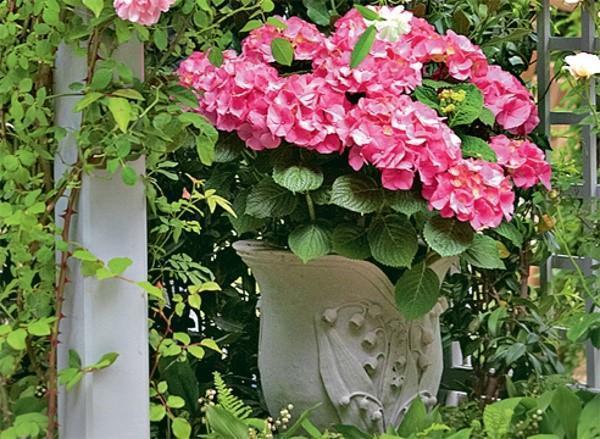Growing a large-leaved hydrangea in a pot: everything you need to know
 Large-leaved hydrangea is a real beauty. Juicy green leaves and large caps of bright inflorescences make it a real decoration of the garden, but there is one "but": the heat-loving beauty does not always winter safely in the open field. Very often, even in the presence of shelter, the shoots of the bush freeze slightly and this deprives gardeners of the pleasure of admiring the flowering next season, and this is the main advantage of the plant. However, not everything is so sad and there is a good way to avoid this situation and preserve flower buds - is to grow hydrangea as a pot culture. Of course, this slightly changes the care of her, but, in general, it will not cause much trouble, even more, it is much easier to care for a compact bush. But what exactly needs to be done, we'll talk about it today.
Large-leaved hydrangea is a real beauty. Juicy green leaves and large caps of bright inflorescences make it a real decoration of the garden, but there is one "but": the heat-loving beauty does not always winter safely in the open field. Very often, even in the presence of shelter, the shoots of the bush freeze slightly and this deprives gardeners of the pleasure of admiring the flowering next season, and this is the main advantage of the plant. However, not everything is so sad and there is a good way to avoid this situation and preserve flower buds - is to grow hydrangea as a pot culture. Of course, this slightly changes the care of her, but, in general, it will not cause much trouble, even more, it is much easier to care for a compact bush. But what exactly needs to be done, we'll talk about it today.
When to transplant hydrangea after purchase?
Most flower growers go in search of new green pets after the end of winter. Towards the end of spring, hydrangea also appears in nurseries or flower shops - seedlings are usually sold in containers, and often even together with buds. Having acquired such a bush, you do not need to do anything special with it: the plant may well be in such a pot until the end of summer, moreover, in the open air, and although the soil is transportable, for the first time it will cope with its task. Naturally, you need to monitor the moisture and prevent the soil from drying out.
But with the arrival of autumn, already at the beginning of September, it will be necessary to prepare the hydrangea for wintering indoors, and at the same time transplant.
What soil to plant?
For indoor hydrangeas often they purchase ready-made soil mixtures containing the necessary nutrients. For a potted hydrangea, it is better to prepare such a substrate yourself by mixing:
- coniferous litter;
- garden land;
- peat.
The resulting soil mixture will satisfy the plant's need for fertile soil, and (which is important) for the required level of acidity.
When and where to harvest hydrangea for the winter?
After transplanting, the bush should not be immediately brought into the house - let it wait for the first frost. When, after the first cold night, the foliage withers and begins to fall off, the hydrangea can and should be taken from the street.
The optimum temperature for wintering hydrangeas is not lower than 5 degrees of frost and not higher than 10 degrees of heat. It could be a basement or a cold terrace.
What to do with potted hydrangea in spring?
Around the end of March, the overwintered hydrangea must be taken out of the basement, spilled with warm water and fed. If necessary, the bush can be transplanted into a more spacious flowerpot, and after watering it must be mulched in order to delay the evaporation of moisture. Before "moving" to the street, the pot needs to find a bright spot in the house.
For feeding, it is better to use a special complex fertilizer for hydrangeas of prolonged action (in granules). Coniferous litter or pine bark is well suited as mulch - when rotting, it additionally acidifies the soil, and hydrangea loves it.
It is possible to take out a hydrangea into the garden not earlier than the end of April, or even in May, but at first, at night, take it into the house or cover it with agrofibre so that the bush does not suffer from recurrent frosts.
Particular attention should be paid to the location of the hydrangea in the garden, because it does not like too bright lighting, from which the flowers fade.As long as there are no buds, the east side is best. And during flowering, it is worth completely removing the bush under a canopy so that the sun hits it only in the evening.
How and what to water?
Like any potted culture, hydrangea needs frequent watering, moreover, the soil in the pot should be moist all the time, but there are also some nuances here. The flower prefers rainwater, but it is better to bring it artificially. If you leave the flowerpot in the rain, the buds get wet, become heavy and may even break, and the bush will lose its shape.
How to trim?
Hydrangeas up to 6 years old can not be cut, only during the summer, periodically remove faded inflorescences (the cut must be done before the first bud). And for older bushes, the main pruning is carried out in the spring, mainly thinning, removing the shoots that thicken the crown. The tops of the branches cannot be touched - they will bloom.
class